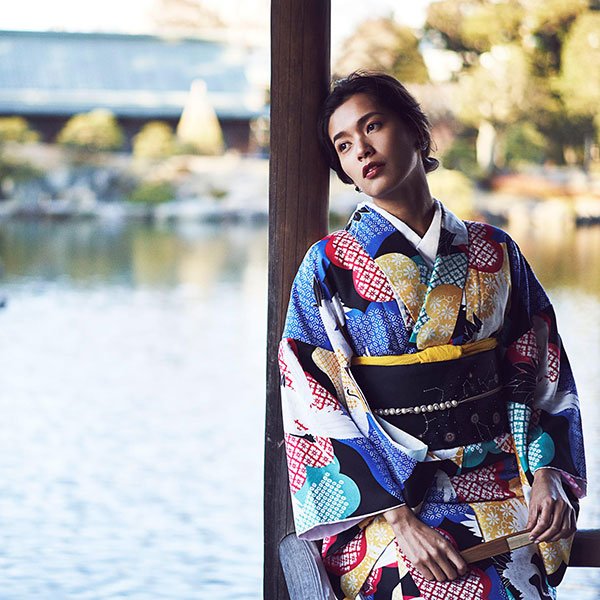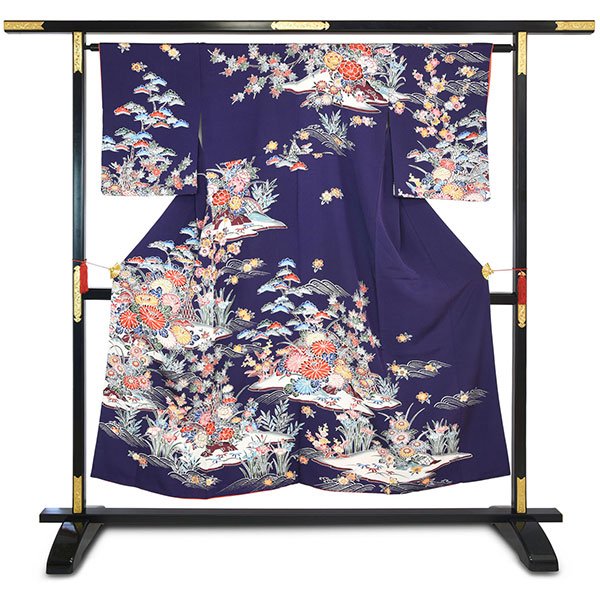Kimono Designs: 9 Must-See Japanese Masterpieces
by Anna Jamieson | CRAFT
Uchikake, from the V&A Museum
The kimono is one of Japan’s most recognizable cultural symbols. The rich array of designs and patterns that they present are the result of time-honored craftsmanship and original creativity. Kimono are intended to be appreciated beyond their function as an art form in their own right.
We’ve selected some of the most sublime, unusual and ornate kimono designs in museum collections in Japan and across the world; showcasing both traditional and one-of-a-kind motifs, as well as the enduring techniques and innovative ideas employed to make these exquisite artworks.
Whether you’re looking for design inspiration or simply to learn more about kimono, read on to explore 9 examples of finest Japanese kimono you can find!
Wherever you are in the world, you can shop for authentic Japanese kimono and yukata at the Japan Objects Store, or if you want to hit the streets in Japan take a look at our guides to the best stores in Tokyo and Kyoto. You can also check out our How to Wear Kimono video tutorial and kimono size guide to make sure you know your size and can get ready to hit the street straight away.
1. Mount Fuji
Mount Fuji Kosode Kimono, from the Nara Prefectural Museum
Mount Fuji takes center stage in this striking kimono design, with gorgeous abstract swirls of white representing the clouds that circle aroud Fuji-san’s crested top. As they billow and curl, you can see dragons start to take form among them
This kimono takes the shape of a kosode, the basic Japanese robe shape. Suitable for both men and women, kosode means small sleeve and refers to the sleeve’s opening. This particular nineteenth-century garment can be found in Nara Prefectural Museum. With its soft colours, subtle tones of icy blues, grays and peach and silk texture, it’s no wonder this is one of the treasures of the museum’s collection.
Natural motifs commonly appear within kimono patterns, and it’s no surprise that Mount Fuji with its auspicious symbolism should be one of the most popular designs.
Take a look at our helpful Visual Guide for explanations of the different types of kimono.
2. A Dyeing Art
© Itchiku Kubota, Fuji and Burning Clouds
In this piece, a highlight from the renowned Kubota Collection, Fuji once again breathes drama into the scene: set against a sunset sky, and framed by a flickering abundance of burning, fiery red clouds. Itchiku Kubota, long considered the most important Japanese textile artist of the 20th century, is responsible for rediscovering an ancient Japanese dyeing technique.
This 15th century Tsujigahana technique relied on tie-dye, using drawings and foil impressions to create its designs. Through this method, each kimono design takes a staggering year and a half to complete. By the end of the 16th century such time-consuming skills were gradually abandoned for more efficient methods. But Kubota recognized the unique potential for the creation of his own art, and worked over several decades to revive the lost technique, now commonly known as Itchiku Tsujigahana.
To create such tantalizing colors, the pattern is first transferred from a preliminary drawing to the silk crepe fabric, which is then dyed. This is the especially tricky part, as each colored dye will react differently with the fabric. Each tone must be applied separately, before the fabric is steamed and the colors are fixed.
If you are near Mount Fuji you should visit the Itchiku Kubota Museum. Quite apart from the incredible kimono, the Gaudi-esque entrance, and luxuriant grounds make you feel like you’ve entered another world.
3. Kimono Costume
Uchikake, from the V&A Museum
Here we see an exuberantly designed uchikake, or outer kimono, which tells the story of the Chinese legend Shakkyo, and the 17th century Battles of Coxinga. These dramatic narratives and flamboyant colors means that it is highly likely this kimono was a costume for a kabuki theatre performance.
We can see the different ways specific features have been applied; whilst the figures and flowers are dyed in bright colours, made from crepe silk, applied by hand and outlined with gold-wrapped thread, the other elements, including the clouds, bridge and leaves are embroidered in gold thread. The drama of the kimono design is reinforced by padding applied to certain areas to create a real three-dimensional canvas.
Kimono owners often have some fascinating stories to share about their treasured garments. Sheila Cliffe has spent many years collecting these Life Lessons from the Kimono Closet. Take a look to find out more!
4. Spring Kimono Design
© Yucho Kubota, Homongi Kimono with Poppies
Another design from the hand of a Kubota, this time Yucho Kubota. Here we see a more minimalist design of decorative flowers with tall, slender stems adorning the yellow fabric, capturing the changing of the seasons, as the poppy buds begin to bloom.
Yucho Kubota has created here a very elegant homongi kimono. These types of kimono are traditionally worn by married women, and are usually slightly less colorful than the furisode worn by unmarried women. Nevertheless, they are far from plain, as you can see!
This graphic style is a marker of a more modern piece. This kimono utilises the Kaga Yuzen dyeing techniques, characterized by its distinctive use of color and vivid patterns.
Want to learn more about this technique? The Kaga Yuzen Center in Kanazawa is a great place to start!
5. Local Flavor
Kabuki Kimono, from the Fukuoka City Museum
You can see at a glance that this stunning red kimono was created to bring good luck! It was used for a local Kabuki performance in the tiny southern island of Oronoshima. A dragon’s face, twirling fans and swirling gold embroidery decorate this richly ornate piece, mostly likely worn by young women performers.
The versatility of kimono as a canvas means that it has long been adapted to local conditions, fabrics, styles and cultures, able to carry a limitless array of symbolic meanings.
6. Tale of Genji
Uchikake, from the Museum of Fine Arts, Boston
This stunning kimono, with its eye-catching red silk-lined hem and three layers of white, purple and peach, shows a beautiful water scene from the world’s first novel, the Tale of Genji. This is another example of an uchikake, or outer robe, with long sleeves and a padded hem. On the top third of the kimono, we see three family crests adorn each shoulder and the back.
This garment also uses the Kaga Yuzen style to harmoniously combine the colors, as well as very subtle use of gold leaf. In particular the artist used a technique known as sunago, where fine gold leaf is ground to a powder and carefully flicked onto the desired portions of the artwork. You can find out more about Yuzen over at 5 Things You Should Know About Yuzen Kimono.
7. Kimono Embroidery
Dyed and Embroidered Kimono, from the V&A Museum
Dating from around the 1860s, this ornate gold and moss green kimono, with its hand painted and dyed menagerie of cranes moving amongst creeping pines and plum blossom, marks the meeting point between painting and the textile arts.
Now in residence in London’s V&A Museum, the piece serves as a work of art in its own right; the fabric almost functioning as a delicate canvas or scroll. As well as the hand-application of the paint, specific parts of the piece have been embroidered to bring a glimmering focus to some of the features: the crests of the birds and fragments of the pine boughs.
8. A Pearl among Kimono
© Tamiya Raden, Shell Kimono
Kimonos can be expensive luxury items, but this gem by Tamiya Raden goes one step further: glittering seashells are actually woven into the thread of the silken fabric! The colors that can be produced in this way an incomparably richer that can be achieved with even gold thread.
Find out more about the incredible Tamiya Radan here!
9. Holy Robes
Noh Costume with Crests, from the Met Museum
Peppered with over 20 crests, this silk-satin kimono dates to the second half of the 18th century. The crests are embroidered onto the fabric, some including a beautiful gold leaf design as well. Each different crest has a different meaning: many replete with religious symbolism such as the reverse swastika, otherwise known as manji, and the circular Buddhist wheels. Others are more decorative in nature, meaningful through their colorful backgrounds.
These kimono are Noh theater costumes known as Nuihaku. They are often worn turned down at the waist, their colourful and eye-catching features relates specifically to their function. They are typically worn by male actors playing female characters. Learn more in our Complete Guide to Noh Theater.
10. Japan Objects Store
Have you fallen in love with kimono, and would like one for yourself? At Japan Objects Store, you can browse a selection of Kyoto-designed kimono, yukata, and obi, as well as authentic and easy-to-wear kimono-style robes. Many designs are available in larger sizes to suit everyone! We curate some of the best Japanese kimono brands and artists including magnificent silk brocade wallets, makeup bags and clutches by the award-winning Tatsumura Textile. You also have the option of free shipping to wherever you are in the world!
Website: shop.japanobjects.com


















ART | October 6, 2023